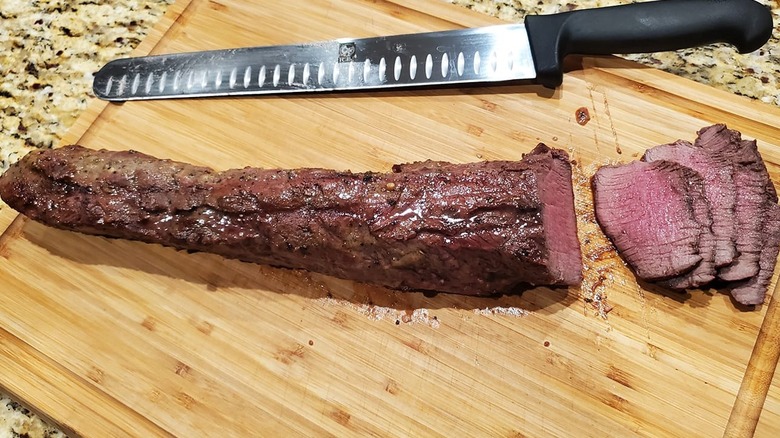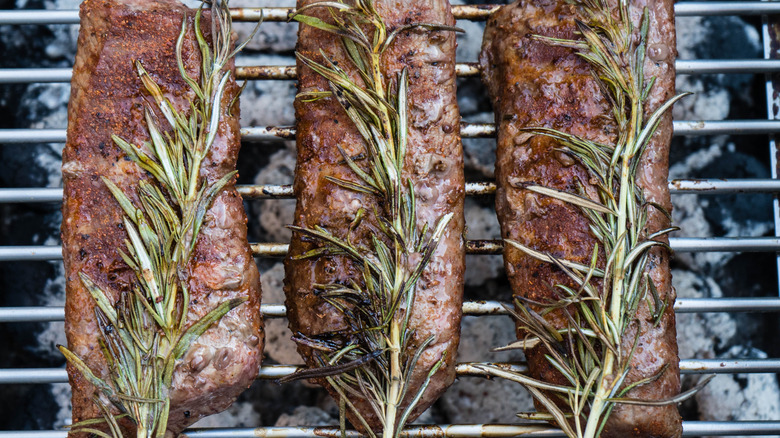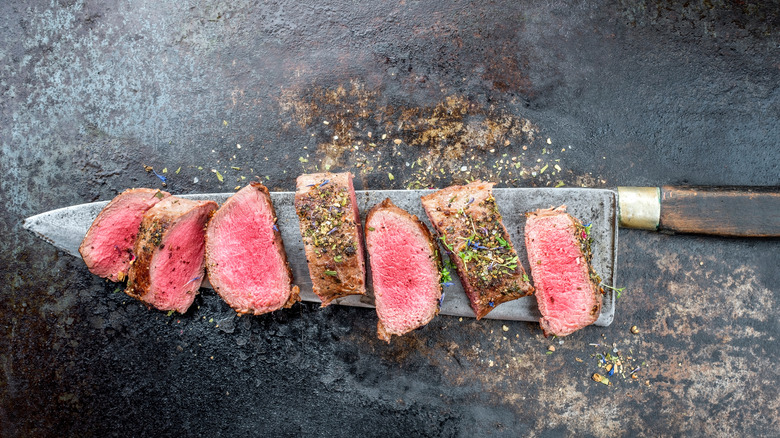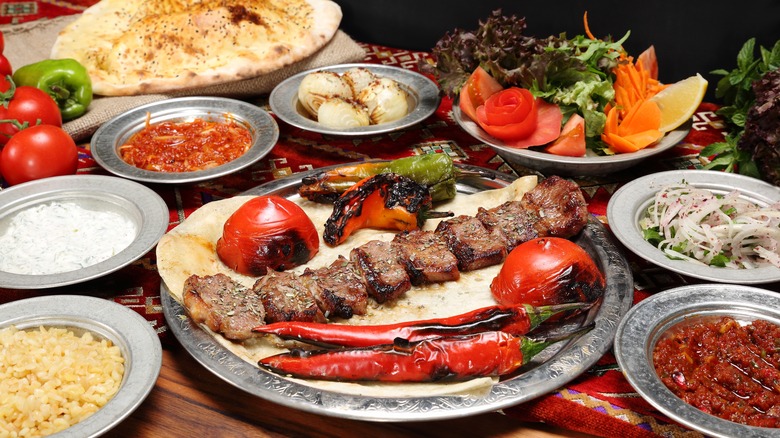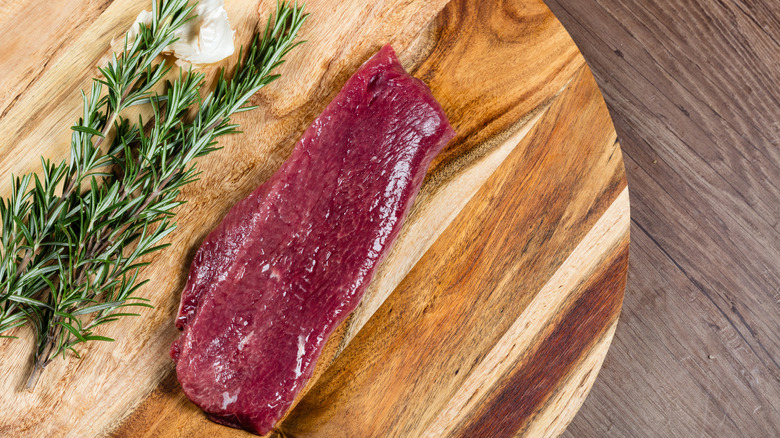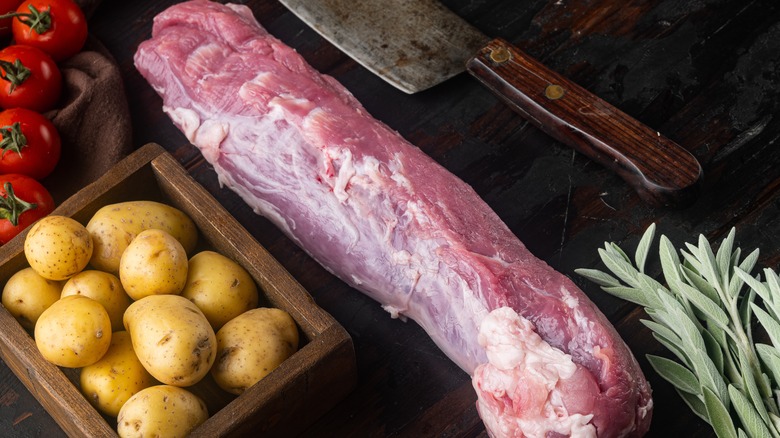What, Exactly, Is Backstrap Meat?
In Irish mythology, several epic battles are started over the curadmír — the hero or champion's portion of roasted meat served at a feast. Historians think that the heroes of the time preferred thigh meat, but if you offered people in the know their choice of cut these days, most of them would choose the backstrap.
If you've never heard of backstrap meat before, you may wonder whether the term refers to a particular steak, or a particular cut, or is just a way to refer to long, thin, tender pieces of meat. The backstrap is actually a muscle found on all edible animals, from rabbits to buffalo. Because of portion sizing, how the meat is butchered, and how prized and expensive backstrap meat is, it's a term that's mostly used for the choicest cuts obtained from medium-sized animals such as deer and sheep.
Backstrap meat comes from the muscles of the back on either side of the spine that do the least work in four-legged animals. These muscles don't need to carry heavy loads like the shoulder or propel the animal forward like the thighs, so they stay incredibly tender. The supple softness of these muscles, combined with the fact that their small size makes them relatively scarce, means that people are willing to pay premium prices for beef backstrap meat — though they might know it by other names, such as New York Strip and ribeye steaks, among others.
What is backstrap meat?
The scientific name for the muscle we call the backstrap is Longissimus dorsi. It's a long, thin, cylindrical muscle that runs along the spine and ribs from the lowest rib up to the shoulder blades. In humans, because we walk on two legs, the muscle is involved in holding our bodies upright and stabilizing our torsos as we bend backward or sideways. Four-legged creatures spread their body weight more evenly across their hips and shoulders, meaning the mid-back does comparatively little work. The more work a muscle does, the more collagen builds up in it, which makes the meat tougher. Because the Longissimus muscle gets used less, backstrap meat is lower in collagen and particularly tender.
If you've ever seen a pork chop, a tomahawk steak, or a rack of lamb, you've seen a portion of backstrap meat with a rib and varying amounts of other meat still attached. The circular 'eye' of the cut is a cross-section of the Longissimus dorsi muscle. Although it is a prized, premium, and relatively rare cut, it's not an insignificant piece of meat, although how many people it will feed clearly depends on the size of the animal in question.
Although backstrap meat's low collagen content does make it tender, the Longissimus muscle also doesn't build a lot of fat inside the tissue. This means the meat is rich and lean but prone to drying out and is easily overcooked if you're not careful.
Backstraps vs tenderloins
Backstrap meat is not hard to find: Butchers in America will likely sell some kind of backstrap. There will be a chop, a fillet, or even lean shish kebabs made from backstrap meat — but it's unlikely to be labeled as such. If you're getting meat to cook that is called "backstrap," chances are it is venison of some kind.
Hunters love their backstraps. The Deer Association called it "America's most desirable cut of meat." However, sometimes you'll get venison that you're told is backstrap, but in fact, is not. It's quite common for people to use the terms backstrap and tenderloin without paying heed to the biological distinction, and it's not hard to see why. Both cuts are notably tender, small, cylindrical, and highly prized. However, tenderloins are not from the outer back at all but form the inside rear of the stomach wall, further down towards the hips and the ground than the backstrap.
Unlike tougher cuts of meat that might be hung up for weeks to improve their flavor and texture, fresh backstraps and tenderloins are tender enough to enjoy in camp. This means that a large proportion of tenderloins and backstraps can get cooked at the same time and in the same way, which makes it easy to conflate the two cuts.
How to cook backstrap meat
Cooking backstraps should be an exercise in restraint. Backstraps are low in fat and connective tissue, but wild game backstraps require removing any fat or silver skin from the backstrap before you cook it. Conventional wisdom says extra fat keeps meats moist, but deer fat leaves a weirdly waxy feeling in your mouth that is not worth the minimal difference it'll make. The connective tissues from a hardworking, wild animal are also particularly tough. If stewed they become tender and melting, but in the time that backstrap meat will cook, the silverskin will only add chew and a gamey twang to the pure, lean meat of the backstrap. Because there's so little in backstrap meat other than pure protein, moisture-retaining techniques such as dry-brining, bacon-wrapping, or butter-basting the meat as it cooks are well advised.
You can sear the backstrap on the highest heat possible, or smoke it low and slow — but what you must not do in either case is overcook it. Use a meat thermometer to make sure you get an internal temperature of around 135 F — medium rare, or it will dry out. Backstrap meat can also be used to make venison tartare, with those who opt to do so freezing the meat for at least 2 days per CDC advice on toxoplasmosis, but eating raw meat is always a risk and the only way to be fully sure it is safe is to cook it to 145 F.
Nutritional information about backstrap meat
Backstraps are known for being lean, tender meats that are high in protein and low in fat. Moreover, loads of essential nutrients like niacin, iron, potassium, zinc, and B vitamins are all in venison meat. Comparing USDA nutrition data between venison and beef backstraps, we can see that 100g of venison and beef both contain around 30g of protein, but venison has only 149 total calories compared to beef's 198. The fact that venison backstrap is lower calorie than beef may come down to the lower fat percentage in venison — just 2.35% versus beef's 8.32%.
For the record, beef backstrap is still flavorful, luxurious, and nutritious. Chateaubriands and steak tartare will always have a place in our hearts. However, according to UPenn Extension, venison is the "perfect choice of protein for those who suffer from cardiovascular disease and are searching for low cholesterol and saturated fat protein choices." This is especially true of venison backstrap, the leanest cut on the deer.
Varieties of backstrap meat
Depending on how thick you cut them, you can make 10 to 20 steaks from a whole beef backstrap — the strip loin, weighs 10-15 pounds. If you want to cook it like a prime rib (which includes the backstrap, plus other nearby muscles) as a whole, roasted centerpiece, an entire strip loin would have enough for 20 to 30 portions, comfortably. Thanks to the extra marbling that modern-day steers develop, beef backstrap is the most forgiving and juicy of the backstraps.
Wild game backstraps are much leaner than their farmed counterparts. While smaller species of deer may have backstraps small enough for individual portions, Elk have backstraps weighing from around 8 to 15 pounds each, which isn't far away from what you get from a cow. Because wild backstraps are so lean, they are often kept moist with the help of extra pork or dairy fats like bacon grease or butter.
Pork and lamb backstraps come in chops, as racks, or as whole loins. Lamb benefits from being cooked to medium rare, like beef or game, but has more fat, which makes for a juicy chop. However, people traditionally prefer pork that's cooked to a higher temperature. This extra cooking is why pork backstrap cuts are often cooked on the bone, or with the fat cap on, to preserve moisture in the meat. If pork backstrap is being cooked on its own, stuffings are often used to achieve the same effect while folding in extra flavor.
